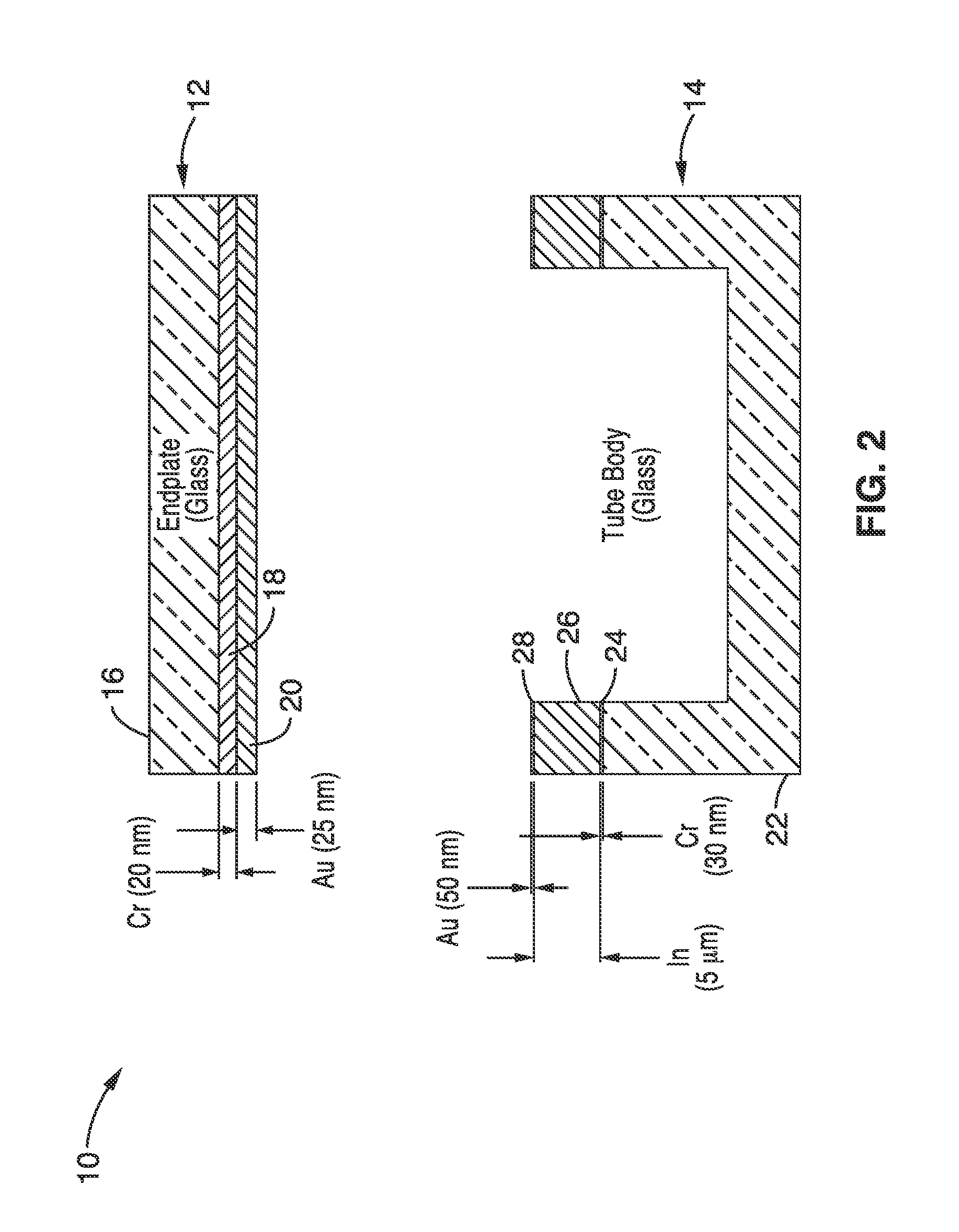Vacuum photosensor device with electron lensing
a photosensor and vacuum technology, applied in the field of vacuum sealed photosensor devices, can solve the problems of insufficiently large-scale production of large-area photosensors, low quality, labor-intensive, etc., and achieve the effects of reducing production costs, reducing production costs, and improving production efficiency
- Summary
- Abstract
- Description
- Claims
- Application Information
AI Technical Summary
Benefits of technology
Problems solved by technology
Method used
Image
Examples
embodiment 10
[0066]Referring first to FIG. 2, an embodiment 10 of an oxide-free sealing means for an ABALONE photosensor device according to the present invention is shown. In FIG. 2, a glass endplate 12 is shown configured for being hermetically sealed to a tube body 14. Layers of material are deposited on both portions to be joined, specifically, the endplate glass 12 of a material 16 and tube body 14 of a material 22 In preparation for sealing. A layer of Chromium (Cr) 18, for example about 20 nm thick, is overlaid with Gold (Au) 20, for example of 25 nm thick, on one element with the other elements being overlaid with a layer of Chromium (Cr) 24 of about 30 nm, Indium (In) 26 of about 5 um and Gold (Au) 28 of about 50 nm. In response to heat the Indium reacts with the Gold to form a Gold-Indium interface.
[0067]The primary role of the Chromium film in the sealing means is to establish a chemical contact with glass or quartz. Chromium breaks the chemical bond between Silicon and Oxygen in thes...
embodiment 50
[0069]FIG. 3 illustrates an uninterrupted vacuum production line embodiment 50, exemplified as the UHV (ultra high vacuum) transfer facility which the inventors have developed at the University of California at Davis. This device is utilized for photocathode deposition and sealing the concave transparent housing to the base plate while retaining an ultrahigh vacuum. The production line 50 is shown with four ultrahigh vacuum chambers 52, 54, 56 and 58, with base pressure lower than 5×10−10 Torr, for fabricating the devices. Each chamber, for example, can be pumped with turbomolecular and ion pumps, with the vacuum quality controlled by quadrapole mass spectrometers. Prototype components travel from one chamber to another for appropriate processing, and finally meet in the central chamber 54 for hermetic sealing.
[0070]A preferred factory will have three separate and specialized lines of chambers, one for each glass component. Those lines would meet in a pair of sealing chambers. The s...
embodiment 90
[0088]Referring now to FIG. 5 through FIG. 9, an embodiment 90 of an open architecture vacuum photosensor device according to the present invention is illustrated. The vacuum seal is facilitated by the oxide-free Indium sealing means previously described, which can be performed simply and rapidly. In addition, the resultant two thin-film seals act together as the only necessary high voltage throughputs to the device. It will be appreciated that no electrode feedthroughs are necessary, which simplifies the production process and utility of the inventive ABALONE photosensor devices.
[0089]The embodiment shown in FIG. 5 through FIG. 9 comprises a vacuum housing portion, herein concave shaped as a first housing (hemisphere) 92 of optically transparent dielectric material 94 having a conductive layer 96 as a photocathode and shown hermetically sealed to a base plate 102 having a through hole 104 into which a readout 106 is sealed. FIG. 5 depicts the hemisphere, base plate and readout in a...
PUM
 Login to View More
Login to View More Abstract
Description
Claims
Application Information
 Login to View More
Login to View More - R&D
- Intellectual Property
- Life Sciences
- Materials
- Tech Scout
- Unparalleled Data Quality
- Higher Quality Content
- 60% Fewer Hallucinations
Browse by: Latest US Patents, China's latest patents, Technical Efficacy Thesaurus, Application Domain, Technology Topic, Popular Technical Reports.
© 2025 PatSnap. All rights reserved.Legal|Privacy policy|Modern Slavery Act Transparency Statement|Sitemap|About US| Contact US: help@patsnap.com



